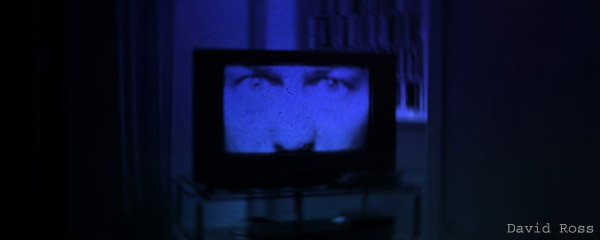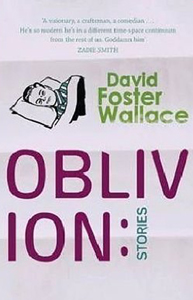
photo by David Ross
A MIRROR OF THE SOUL: OBLIVION
by DAVID FRANKEL
Ten years ago, a colleague gave me a small stack of photocopied pages. “Read it,” he said, “it’s brilliant.”
It was a copy of ‘Incarnations of Burned Children’, a story by David Foster Wallace from his collection, Oblivion. It was one of the most powerful pieces of writing I had ever come across but, despite the beauty of the language, I found myself unable to re-read it for a long time.
Told in a single, three page long paragraph, ‘Incarnations of Burned Children’ is the story of a childhood accident and its aftermath. It is so vividly realised that it is impossible not to become a participant in the events; the intensity of the story isn’t for the faint-hearted.
…before the screen door had banged shut behind him the Daddy had taken the scene in whole, the overturned pot on the floor tile before the stove and the burner’s blue jet and the floor’s pool of water still steaming as its many arms extended, the toddler in his baggy diaper standing rigid with steam coming off his hair and his chest and shoulders scarlet and his eyes rolled up and mouth open wide and seeming somehow separate from the sounds that issued…
Here, the sudden horror of accident is not reduced to shock value, as it could easily have been. Instead, the breathlessness of this stretched moment yields to a haunting ending that ensures it will linger in the mind of the reader. Fortunately the rest of the stories in the collection are slightly easier on the soul – but only a little.
 Wallace was a prolific writer of short stories, but his highly acclaimed novels have tended to overshadow his accomplishments in this genre. Published in 2004, Oblivion was to be his last collection of short stories, written while he was working on his novel, The Pale King. In a letter to his publisher, he described the collection as ‘the best of the stuff I’ve been doing while playing hooky from a larger thing’. It has been suggested that some or all of the stories in Oblivion began as ideas for chapters in The Pale King.
Wallace was a prolific writer of short stories, but his highly acclaimed novels have tended to overshadow his accomplishments in this genre. Published in 2004, Oblivion was to be his last collection of short stories, written while he was working on his novel, The Pale King. In a letter to his publisher, he described the collection as ‘the best of the stuff I’ve been doing while playing hooky from a larger thing’. It has been suggested that some or all of the stories in Oblivion began as ideas for chapters in The Pale King.
It is therefore not surprising that the stories focus on small events unfolding in the shadow of something bigger. Each story charts the internal world of its characters. The main events take place in the periphery of the narratives, while the plots are convoluted, pursuing chains of thought, exploring ideas, following characters down the many blind alleys that make their lives. This is laid bare in ‘Good Old Neon’, a story about the final thoughts of a suicidal advertising executive:
What if all the infinitely dense and shifting worlds of stuff inside you every moment of your life turned out to be somehow fully open and expressible afterward, after what you think of as you has died…?
In this, and Wallace’s other stories, there is complexity and depth behind the characters’ motivations. They are struggling to make sense of their surroundings, self-aware but not necessarily able to understand enough to help themselves. Most of the stories in Oblivion are told in the first person. The characters look straight at the camera and confess – perhaps reflecting the authors own inner world. The narrator in ‘Good Old Neon’ begins the story:
My whole life I’ve been a fraud. I’m not exaggerating. Pretty much all I’ve ever done all the time is try to create a certain impression of me in other people. Mostly to be liked or admired. It’s a little more complicated than that, maybe. But when you come right down to it it’s to be liked, loved. Admired, approved of, applauded, whatever. You get the idea.
This internal life is painted against a backdrop of superficiality and the trivial obsessions of the modern western world. Wallace’s huge output of essays on contemporary life demonstrate his preoccupation with trash culture, media, advertising, consumerism and their stupefying effects. These themes are reflected in his stories, but, unlike many of the writers who engage with this subject matter, he contrasts this with complex inner lives for his characters, fed by his interest in psychoanalysis.
His work is also humanised by a deep, black humour that lurks at the back of most of the stories. This comes to the fore in ‘Philosophy and the Mirror of Nature’. The story takes place on a bus. The narrator, a seven foot albino man is travelling with his mother whose face has been frozen into a ‘chronic mask of insane terror’ by a bungled cosmetic procedure. He tells the story of the events around her fight for compensation and his own legal troubles relating to his black widow spider farm.
Then just as I was being released in late 1996 Mother won a small product liability settlement and used the money to promptly go get cosmetic surgery on the crow’s feet around her eyes. However the cosmetic surgeon botched it and did something to the musculature of her eyes, which caused her to look insanely frightened at all times. No doubt you know the way an individual’s face can look in the split second before they start to scream.
The structures of the stories differ greatly. In contrast to the single, long paragraph of ‘Incarnations of Burnt Children’, most of the other stories in the collection are intricate and complex constructions, combining layers of experience and sensation with the characters’ internal emotional life.
 This is perhaps most evident in ‘The Soul is Not a Smithy’, an astonishing story with a multi-layered narrative. It is told, as many of Wallace’s stories are, by an unnamed narrator. He recalls an episode from his childhood when a teacher suffered a psychotic episode resulting in a hostage situation. In the ensuing siege, he is barely aware of the events around him, as he is involved in creating an elaborate story of his own. Both narratives are woven together and intercut with references to the narrator’s present day. The title refers, perhaps ironically, to the ending of Joyce’s Portrait of The Artist as a Young Man; Wallace’s and Joyce’s characters are both forging, in the smithy of their soul, ‘the uncreated conscience of their age’. In the case of Wallace’s narrator, this is an altogether bleaker prospect.
This is perhaps most evident in ‘The Soul is Not a Smithy’, an astonishing story with a multi-layered narrative. It is told, as many of Wallace’s stories are, by an unnamed narrator. He recalls an episode from his childhood when a teacher suffered a psychotic episode resulting in a hostage situation. In the ensuing siege, he is barely aware of the events around him, as he is involved in creating an elaborate story of his own. Both narratives are woven together and intercut with references to the narrator’s present day. The title refers, perhaps ironically, to the ending of Joyce’s Portrait of The Artist as a Young Man; Wallace’s and Joyce’s characters are both forging, in the smithy of their soul, ‘the uncreated conscience of their age’. In the case of Wallace’s narrator, this is an altogether bleaker prospect.
Few of Wallace’s stories could be considered easy reads. The density of his language, sentences that can be a page long, extensive use of footnotes to elaborate on the main narrative, and the dark psychology behind his material, demand a lot of the reader. He is often criticised for being too clever, but I see no smugness or arrogance in his work. Behind his intellectualism there is something animalistic and compulsive. The stories are engaged with people and it is this that pulls the reader in and delivers an emotional intensity present in the work of only a very few writers. Above all, there is genuine compassion, even in his darker stories. It is this that separates his work from others in his literary generation, in particular that of Brett Easton Ellis, with whom Wallace is often compared.
There is a story that Wallace told in a number of interviews and finally published as part of a speech in This Is Water. It goes like this: Two young fish, swimming along, meet an old fish swimming the other way. He nods and says, “Morning, boys. The water’s lovely today isn’t it?” The young fish swim on, until one of them turns to the other and says, “What the hell is water?”
His point was that the things we are surrounded by, which form the fabric of our lives, often go unnoticed. This hard-to-define quality of life can’t be pinned down, named or described by any other means but fiction, and it is this quality that infuses the short stories in Oblivion.

